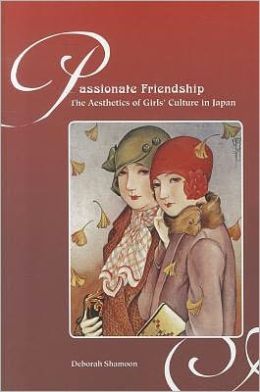Shamoon, Deborah. Passionate Friendship: The Aesthetics of Girls’ Culture in Japan. By Deborah Shamoon. Honolulu, HI: University of Hawai’i Press, 2012.
Sarah Frederick.
Passionate Friendships takes an ambitiously broad look at 20th century girls’ culture, examining the shōjofrom Meiji literature to 1920s girls’ magazines to 1970s shōjo manga. She argues that throughout, girls’ culture produced a set of particular artistic styles and conventions that allowed artists and readers to explore various gender and sexual identities. Shamoon is particularly attentive to the eponymous “passionate friendships,” which appear as “S-relationships” or “spiritual friendships,” and seem to evolve during the 1970s from relationships between girls to ones between boys. She suggests that scholars often misrecognize the meaning of “passionate friendships” when they view small groups of texts from one historical period in isolation or through the scholar’s own cultural lens, often interpreting ambiguous relationships as “repressed” sexualities. She argues that viewing this longer history of girls’ culture, rather than focusing on prewar or postwar periods in isolation, clarifies the continuities and influences at work across this period, as well as the themes and aesthetics of shōjo manga. This latter clarification is presented as the ultimate aim of her research. Although the book does not delve into theories of genre, it clearly shows that attention to it across a long period of time can be productive. She identifies many continuities in shōjowriting, including forms of lyricism, visuality, and orality, and achieves the difficult task of showing how they jump from prose fiction to graphic novels. This long and broad view remains thought-provoking throughout, and, along with its lucid writing and rich illustration, makes the book particularly useful for classroom use. My undergraduate Japanese literature students found it accessible and a strong foundation for looking at primary shōjoculture materials.
It is quite an achievement to pack such a long historical period into such a short book, not to mention so much cross-disciplinary research. There is a tremendous amount of valuable and original research in this book. In particular, the girls’ magazines discussed in the first half of the book are not easily available even in Japan. Shamoon distills this thorough research and the relevant Japanese secondary sources into two chapters, which may now stand as the best single introduction to 1920s and 30s girls’ print culture in English. While the shōjo manga of the 1950s -1970s Shamoon discusses in Chapter 4 and 5 have been relatively accessible in recent years, Shamoon adds details from interviews with manga artists and expert visual analysis that enrich the material and complement other studies.
The book is at its best when performing close readings of visual and thematic qualities of individual texts in context. Despite concision and wide coverage, she successfully zooms in to analyze details from Yoshiya Nobuko’s writing style to the story and aesthetics of Rose of Versailles and Heart of Thomas (Tōma no shinzō). Texts somewhat less known in North America receive careful treatment. For example, Takahashi Makoto’s manga Paris-Tokyo and Sakura namiki come to life through Shamoon’s astute exploration of themes, friendship styles, and formal qualities. She deals with manga-media-specific qualities, such as frame shapes and character placement conventions, including such features as full-body portraits across multiple frames and multiple costumes on a given page, all of which are shown in illustrations. The book turns attention to visual and narratological matters, such as how interior monologue is represented in Hagio Moto’s Tōma no shinzō (115-119). The treatment earlier in the book of prewar visual culture and how typographical marks in Yoshiya Nobuko and other shōjo writings developed a visual culture of emotion creates a strong foundation for understanding the decorated oral style that reappears in later manga text and image. Here the link is quite convincing and helps us to better understand Hagio. The book will be seen as a counterpart to Jennifer Prough’s excellent study of shōjo manga.[1] Prough also does close analysis of manga, but her focus as an anthropologist is on ethnographic data and contemporary materials of the 1990s and early 2000s. Shamoon’s historical perspective and close reading make it different from and quite complementary to Prough’s work.
The author’s purpose does not seem to be to make strong theoretical claims, and many will appreciate the resulting accessibility. But some weaknesses do come from her problematic handling of theory and secondary source material, two topics worth addressing here. Statements such as “While queer readings of boys’ love are possible, the majority of readers are heterosexual, as were the readers of prewar girls’ novels,” (113) leave us unsurprised that queer theory is not engaged in the text or present in the bibliography. This may be outside the scope of Shamoon’s book, but she does mention it, and such approaches may have helped her move beyond a sometimes binaristic and developmental narrative: homosexual or heterosexual; girl or boy; biography or art; good or bad; spiritual or sexual; feminist or conservative, and so on.[2] In fact, Shamoon’s choice of material and her astute analyses of characters and words that blur outside the mangaframe or readers who identify multiply usually serves to move us beyond these binaries, and I believe this is very much her intention. But particularly at moments when others’ scholarship is found lacking these distinctions re-appear and are sometimes applied unfairly.
The book claims a Foucault-influenced genealogy of Japanese girls’ sexuality (34). Throughout Shamoon implies that there is some recoverable correct story of how this discourse develops that she can map from the 1910s to the ‘70s, and which cannot and should not be influenced and clouded by our present discourses or position. But this misunderstands the purpose of such a Foucaultian genealogy and the ways it is meant to disrupt and displace intuitive stories and help us think critically about discourses of our present and our place. The book suggests the origins of shōjo culture to be in the prewar, while “genealogy” is meant to move away from such origin stories. Of course, it is admirable to be cautious about applying terms in anachronistic and essentializing way as scholars and readers sometimes do. She warns us, for example, “to resist the temptation to map a contemporary lesbian ideology onto [Yoshiya Nobuko’s] writing” and to focus on “lyricism, emotion, and orality” in her foundational shōjostyle rather than “interrogating her novels for hints of incipient feminism, lesbianism, or subversion to the heterosexual, patriarchal family structure” or on her biography. As a scholar of Yoshiya, I agree with much of this move to avoid flattening the complexity of what it means to refer to her as a “lesbian writer,” as by focusing exclusively on her most obvious same-sex romance plots, or assuming her to be a certain kind of feminist, or subversive figure. At the same time, Shamoon’s insistent rejection of “lesbian” aspects raises its own problems, and suggests a binary, all-or-nothing choice. On the one hand, already in the early 1920s, Yoshiya is quoting Sappho and has women in an “S” relationship explaining the Island of Lesbos to one another – in thissense the term is not simply anachronistic.[3] In addition, James Welker’s discussion of ongoing debates about the terms resubian and rezubian indicates that critical attention is required at any point in time when using such terms, even when such usage is not anachronistic.[4] Meanwhile terms like “spiritual” have their own complex Euro-American histories equally in need of genealogical precision. But, on the other hand, this road, down which I see myself going here too, simply proposes corrections to the authentic narrative, thus the very antithesis of the genealogy. Ultimately, we must remember that going back in time does not absolve us of attention to discursive and power structures, that there can be no single history of these terms or of shōjoculture. Again, Shamoon provides the materials to see this richness, but sometimes backs away from doing so, perhaps because she is admirably passionate about the strange distortions that have occurred. I grant that moments of same-sex erotics can be interesting to contemporary scholars because of our own subject positions and the concerns, of our moment, and room for this fascination and desire must be granted contemporary Japanese shōjo manga artist sand scholars alike. All of the materials to inspire such connections are here in this book, which could simply dispense with the various admonitions that we should not make them.
While there is admirable inclusion of Japanese and English secondary sources on shōjoculture, too many are left in a dissertation-style literature review format and style, mentioned not for intellectual or evidentiary worth but as exemplars of misguided methodology or lacunae.[5] In some cases, scholars’ remarks are interpreted out of context or in a humorless way. For example, quoting Miriam Silverberg’s afterword to Bad Girls of Japan, “We all know the good girl…. I am not interested in engaging with the good girl,” Shamoon interprets this as “meaning that only bad girls are interesting subjects for academic study” (138).[6] In this and other cases, the distortion is exacerbated by the fact that relevant essays from the volume are not considered. Instead, apparently, the book is largely judged by its title. This detracts from the author’s own scholarship. I wish Shamoon had devoted the space to more of her original research and analysis, rather to weak gestures at carving out space for it. It is clear without such remarks that this is an important subject and good approach.
These criticisms do not change the fact that this is an important work on shōjoculture in Japan. Because of its scope, significant research, and close readings it will likely hold a significant place on syllabi, bookshelves, and citation lists for decades to come.
Sarah Frederick is Associate Professor of Japanese Literature at Boston University and the author of Turning Pages: Reading and Writing Women’s Magazines in Interwar Japan (University of Hawaii, 2006). http://www.bu.edu/mlcl/people/faculty/sarah-frederick/
[1] Jennifer S. Prough, Straight from the Heart: Gender, Intimacy, and the Cultural Production of Shōjo Manga (Honolulu: University of Hawai’i Press, 2011). Shamoon’s own review of Prough in Mechademia provides an excellent précis of this book and its approach: Deborah Shamoon, “Review of Straight from the Heart,” Mechademia, https://www.mechademia.net/2012/11/29/book-review-straight-from-the-heart
[2] Eve Kosofsky Sedgwick emphasizes that along with same-sex object choices, queer can refer to: “the open mesh of possibilities, gaps, overlaps, dissonances and resonances, lapses and excesses of meaning when the constituent elements of anyone’s gender, of anyone’s sexuality aren’t made (or can’t be made) to signify monolithically.” This central aspect of queer theory is absent from Shamoon’s references to it. Tendencies (Durham and London: Duke University Press, 1993), 8.
[3] Yoshiya Nobuko, “Kibara” (Yellow rose), Yoshiya Nobuko zenshū (Tokyo: Asahi Shinbunsha, 1975) 1:228-229.
[4] James Welker, “”Transfiguring the Female: Women and girls Engaging the Transnational in Late 20th Century Japan,” Dissertation. (University of Illinois-Urbana, 2010), 101-127.
[5] One major absence I do feel in her use of central Japanese sources is the work of Kotani Mari, her writing being of such high quality and prominence.
[6] Quote is from the afterword to Laura Miller and Jan Bardsley, eds., Bad Girls of Japan (New York: Palgrave Macmillan, 2005), 191-192.


